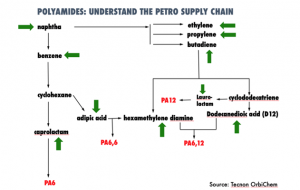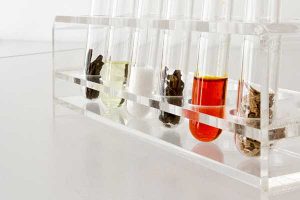
Even though fossil resources have gotten much cheaper in recent years, there are big efforts to replace standard plastics by polymers made from renewable resources. Reduced consumption of fossil resources is especially important because of the climate change issues caused by the release of carbon dioxide. Away from the production of biodegradable polymers — for example, for packaging applications — there is a burgeoning interest in high performance materials made from renewable resources.
Would your formulation benefit from a polyamide?
Register today for access to Prospector’s database of thousands of materials, including polyamides. See data sheets, request samples, and more.

Researchers at the Fraunhofer Institute for Interfacial Engineering and Biotechnology in Germany have developed a process for manufacturing high-quality plastics from terpenes, a waste stream of cellulose production.1 The synthesis of polyamides from terpenes was developed at BioCat – Bio, Electro and Chemocataysis — the Straubing branch of Fraunhofer IGB, under the direction of Professor Volker Sieber.
Terpenes are a renewable resource that is generated in large quantities as a side stream of pulp production as well as in the fruit industry. As a waste stream, the application of terpenes for the production of new bioplastics is not in conflict with the need of food production for humans and animals.
Today, significant amounts of terpenes are not used as a bio-based raw material, but incinerated to aid the energy supply of pulp mills. But because of the complex structure of the terpenes, a much higher value application is desirable.
Researchers expect to be able to manufacture products like coatings, textiles and adhesives from the bio-based polyamides. Up to now, these bio-based plastics have been manufactured only in the laboratory, but the plan is to develop a synthetic route which allows future production on an industrial scale.
Elsewhere, another novel high-performance bio-based polyamide, poly(pentamethylene oxamide), exhibits excellent mechanical, thermal, and water absorption properties, and is suitable for the fabrication of plastic parts for the automobile and electronics industries.
1,5-pentanediamine (also known as cadaverine) is a potential renewable candidate to replace hexamethylenediamine in the production of polyamide (an important polymer in the plastic and textile industries). To date, however, yields of 1,5-pentanediamine have been too low for commercialisation and only recently has cadaverine been produced on a mass scale.
Cadaverine can be used to produce a variety of polyoxamides — a class of polyamides that include the shortest possible diacid link (an oxalyl unit) in their parent chain. These have recently attracted attention because they exhibit high chemical resistance, melting temperature, modulus, and UV light stability, as well as low water absorption and solubility properties. They include:
- poly(pentamethylene succinamide) (PA54)
- poly(pentamethylene hexanediamide) (PA56)
- poly(pentamethylene decanediamide) (PA510)
- poly(pentamethylene eicosanediamide) (PA520)
In particular, it has been shown that PA510 has a low water uptake compared with nylon 6 and 66 (PA6 and PA66). This means that PA510 has good dimensional stability and mechanical properties, and it is well-suited for energy-friendly transportation (because of its low density). It has also been demonstrated that PA56 exhibits good thermal properties and a special crystallisation behaviour.
Despite these attractive engineering properties, polyoxamides have not yet been widely commercialised. Ube Industries Ltd (Japan), however, has recently initiated pilot commercial runs for poly(nonamethylene oxamide) - PA92 - which has been intensely studied for many years and has been shown to have good properties.
Another novel bio-based polyoxamide is poly(pentamethylene oxamide) or PA52. This can be synthesised from dibutyl oxalate and 1,5-pentanediamine with the use of a conventional two-step polymerization technique (pre-condensation in solution and post-condensation in the solid state).
Compared with commercially available polyamides — PA6, PA66 and PA46 — PA52 exhibits a high melting temperature, good mechanical properties, low water absorption, and excellent crystallisation characteristics (see Table 1 below). PA52 is thus well suited for high-temperature, high-performance parts in the automobile and electronics industries. PA52 thus has great potential to compete with and replace fossil-fuel-based polyamides.
| Property | Polyamides | |||
| PA52 | PA46 | PA6 | PA66 | |
| Melting temperature (°) | 302 | 295 | 220 | 258 |
| Heat of fusion (Jg-1) | 90.7 | 91.0 | 57.0 | 50.0 |
| Crystallization enthalpy (Jg-1) | 85.6 | - | 40.0 | 49.0 |
| Glass transition temperature (°) | 125 | 80 | 54 | 60 |
| Decomposition temperature (°) | 449 | 350 | 448 | 458 |
| Water absorption (wt%) | 3.2 | 12.4 | 10.0 | 9.0 |
Table 1. Summary of the properties of PA52, compared with those of three commercially available polyamides, i.e., PA46,14,15 PA6, and PA6614).4PA46: Poly(tetramethylene adipamide). PA66: Poly(hexamethylene adipamide).
At the 10th International Conference on Bio-based Materials in May 2017, Kado announced it was focusing on the production of novel specialty chemicals by biological techniques and replacing incumbent product by a bio-based equivalent with similar characteristics.
The views, opinions and technical analyses presented here are those of the author or advertiser, and are not necessarily those of ULProspector.com or UL Solutions. The appearance of this content in the UL Prospector Knowledge Center does not constitute an endorsement by UL Solutions or its affiliates.
All content is subject to copyright and may not be reproduced without prior authorization from UL Solutions or the content author.
The content has been made available for informational and educational purposes only. While the editors of this site may verify the accuracy of its content from time to time, we assume no responsibility for errors made by the author, editorial staff or any other contributor.
UL Solutions does not make any representations or warranties with respect to the accuracy, applicability, fitness or completeness of the content. UL Solutions does not warrant the performance, effectiveness or applicability of sites listed or linked to in any content.



Hi Andy,
Very nice piece on biobased polyamides. I have not heard of Terpene-based polyamides, but it sounds like a very interesting technology. I did, however, find it odd that in an article about biobased polyamides you neglected to make any mention of Polyamide 11, a high performance long-chain polyamide that is derived from the the castor plant. Arkema’s Rilsan® PA11 brand is actually celebrating its 70th anniversary this year. You can read the press release about the brand here: http://www.arkema.com/en/media/news/news-details/Arkema-celebrates-the-70th-birthday-of-its-flagship-Rilsan-polyamide-11-brand/
Regards,
Ryan
Thanks Ryan. You are quite correct. I was merely focusing on new developments, but thank you for adding the link about nylon 11.